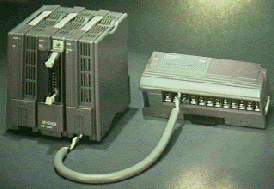
What is a PLC?
 A PLC (i.e. Programmable Logic Controller) is a device that was invented
to replace the necessary sequential relay circuits for machine control. The
PLC works by looking at its inputs and depending upon their state, turning
on/off its outputs. The user enters a program, usually via software, that
gives the desired results.
A PLC (i.e. Programmable Logic Controller) is a device that was invented
to replace the necessary sequential relay circuits for machine control. The
PLC works by looking at its inputs and depending upon their state, turning
on/off its outputs. The user enters a program, usually via software, that
gives the desired results.
For example, let's assume that when a switch turns on we want to turn a solenoid on for 5 seconds and then turn it off regardless of how long the switch is on for. We can do this with a simple external timer. But what if the process included 10 switches and solenoids? We would need 10 external timers. What if the process also needed to count how many times the switches individually turned on? We need a lot of external counters.
As you can see the bigger the process the more of a need we have for a PLC. We can simply program the PLC to count its inputs and turn the solenoids on for the specified time.
I believe this tutorial will give you enough information to be able to write
programs far more complicated than this.





 A PLC (i.e. Programmable Logic Controller) is a device that was invented
to replace the necessary sequential relay circuits for machine control. The
PLC works by looking at its inputs and depending upon their state, turning
on/off its outputs. The user enters a program, usually via software, that
gives the desired results.
A PLC (i.e. Programmable Logic Controller) is a device that was invented
to replace the necessary sequential relay circuits for machine control. The
PLC works by looking at its inputs and depending upon their state, turning
on/off its outputs. The user enters a program, usually via software, that
gives the desired results.



